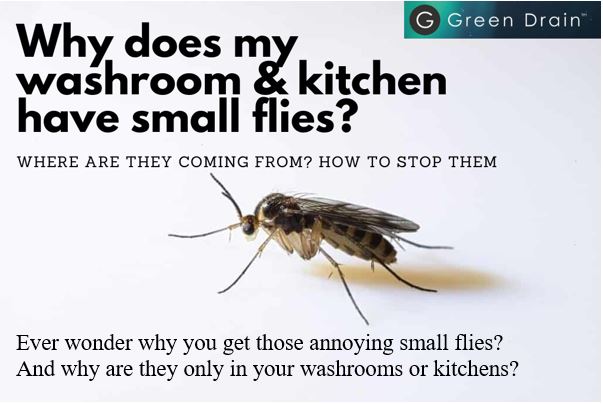
The Answer is WASTEWATER, Eddie Bocchino – MD of Green Drains Asia Pacific explains,
Our drainage network is rife with biofilm, a bacterial filled sludge that mixed with water, creates a perfect environment for breeding small flies and housing pathogens.
Business owners re-invest millions of dollars and countless hours to ensure their venues look good are hygienic and attract the right audience on social media platforms. These annoying pests can leave the wrong impression or worse, spread infection and disease.
To stop them we must understand them!
Insects need stagnant water to survive and continue their breeding. And if we think Q. where is there stagnant water…? A. Our wastewater inlets provide such a haven. That’s why they are only found in our kitchens and bathrooms.
With the unstable weather patterns and increasing temperatures, these little guys are thriving and on the increase. Pouring commercial chemicals or home remedies only go so far. It doesn’t make sense to leave our drains unprotected, as they’ll keep coming back!
They remain about 10m to 15m from where they breed. The female insects can lay upwards of 200 eggs at a time. On average they take approximately 10-12 days to incubate and can be active within 8 hrs of hatching. They don’t last long, however the sheer number of them coming out of the drains and other wastewater inlets can be a major challenge to portray a hygienically safe environment for staff and patrons of any commercial or residential buildings.
Green DrainsTM will help prevent fly infestation from your drains by blocking off their breeding cycle, without the need for harsh chemicals.
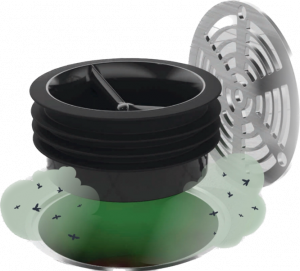 It’s multi-patented design is SIMPLE & RELIABLE. The Green Drain™ allows the flow of water and debris, whilst blocking gases, odours and bugs that contaminate your space.
It’s multi-patented design is SIMPLE & RELIABLE. The Green Drain™ allows the flow of water and debris, whilst blocking gases, odours and bugs that contaminate your space.
We protect our hands and surfaces with gloves, masks and chemicals, so why don’t we protect our wastewater inlets that are directly connected to our sewer pipes?
Whilst most venues fight common challenges ODOURS, PESTS, HYGIENE and PATHOGENS, they disregard what is out of sight. Wastewater and the drainage network is the source of contamination, and offers little protection when left exposed.
Drain flies pose a problem in many environments with the one we’re focused on in this article being food service venues such as restaurants, cafes, school cafeterias, hotels, commercial kitchens, hospital kitchens and catering environments to name just a few.
What causes drain flies?
Drain flies thrive in stagnant water. Common sources of these instances are clogged drains, rarely used and unused toilets, and standing water resulting from faulty or leaking pipes. The flies typically enter buildings through windows and drain holes where they find the stagnant water in the pipes which is the optimal environment to dwell, reproduce, thrive, and present unsuspecting issues.
Who should be most concerned about drain flies?
Post-COVID lockdowns, return-to-work businesses were at the most risk to drain flies. This was due to the long period’s businesses were closed with pipes left with stagnant water which is an attractive venue for these little insects. They seem harmless and few realise they come from the long unemployed drains when they see these critters. It’s also no surprise most see them as harmless and don’t consider the possible impact on their business when the venue commences operation again.
What’s the cost of a poor first impression or online reviews?
Imagine going to a nice restaurant and the toilets smell and have flies or there’s a fly in your salad… What would you think? Who reads reviews? So what if my kitchens or toilets have drain flies.
Are you willing to risk a poor online review or worse still having your kitchen closed due to safety concerns of pest infestations?
Others who need to be concerned are those who are active but experience an abundance of these insects. It’s a signal there is stagnant water that needs to be treated and the cause needs to be repaired. This is most important for food preparation and service environments as the chance of impact to the health and well being of not only your customers, but your staff too may be unrecoverable.
How to prevent drain flies?
There are many ways to prevent drain flies from impacting your business operations and the safety of everyone who enters your venue, from staff to customers.
Sealing your wastewater inlets and drains
Green Drain are one-way trap seal valves for water inlets. This handy drain accessory not only prevents pests from entering your drains, but it also has the added benefit of blocking odours, pathogens and gases from entering working and food preparation spaces. Green Drain offers drain seals in various sizes with options available for each drain size and type to help ensure you’re protected from unsuspecting drain flies. The Green Drain features four pliable sealing ribs and a self sealing silicone skirt which have been tested and are guaranteed to allow drainage of water then immediately close after flowing has ceased to prevent insects, odours, pathogen spread, and gases.
Bio Active Treatments
Bio Active Treatments are an innovative cleaning solution that contains live pro-biotic bacteria. These hard workers target other bacteria that cause odours as well as the organic sludge that leads to pipe blockages, poor drainage flow, pathogens and malodour.
Case study MONDO ORO small goods manufacturer, Perth WA
Mondo Doro regularly and proactively work with their chemical supply partner, Chemform to prevent any outbreaks and pest infestations by swabbing drains and surfaces to ensure their product and staff are hygienically safe.
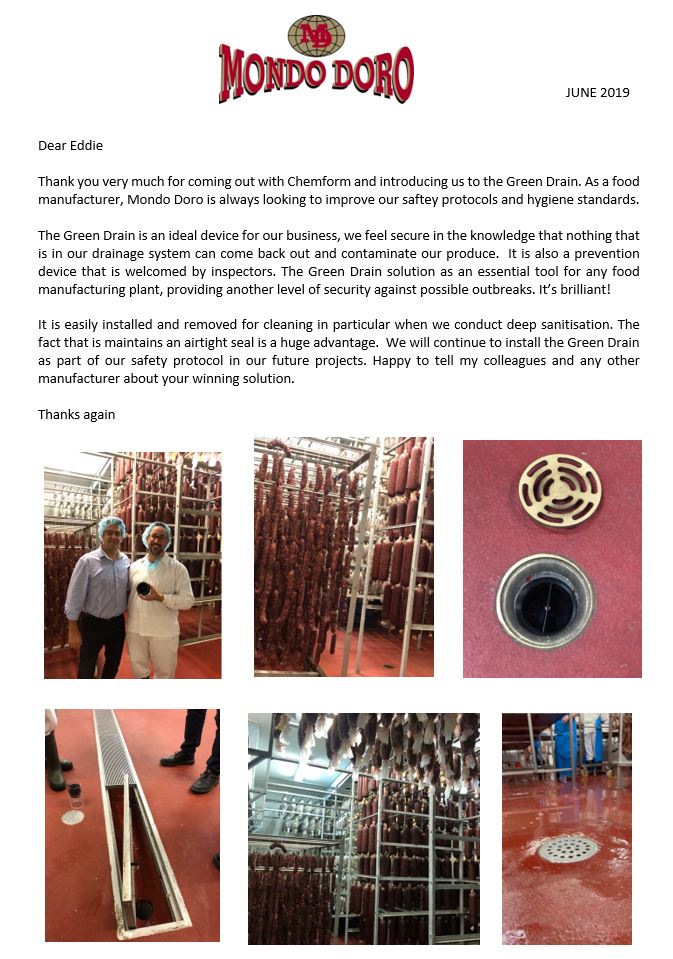
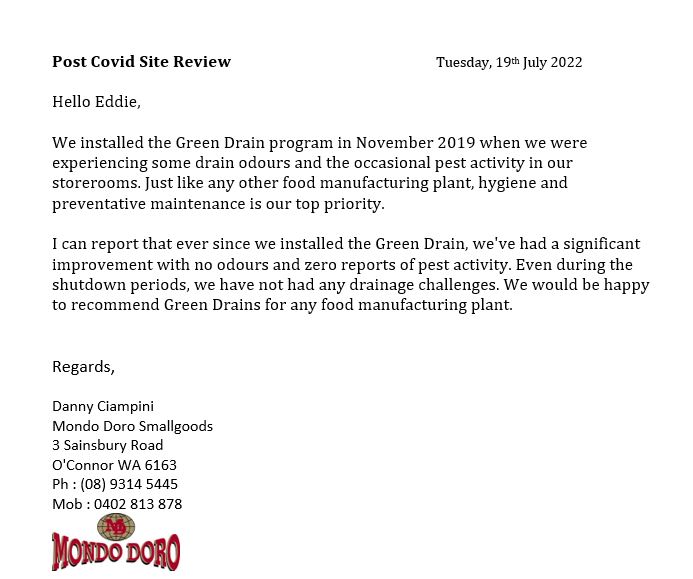
Green Drains is proud to partner and be certified by HACCP International as our aim is to safeguard our living and working space from wastewater inlets and unprotected drainage networks. Our distribution partners value the quality and reassurance of the HACCP International logo displayed
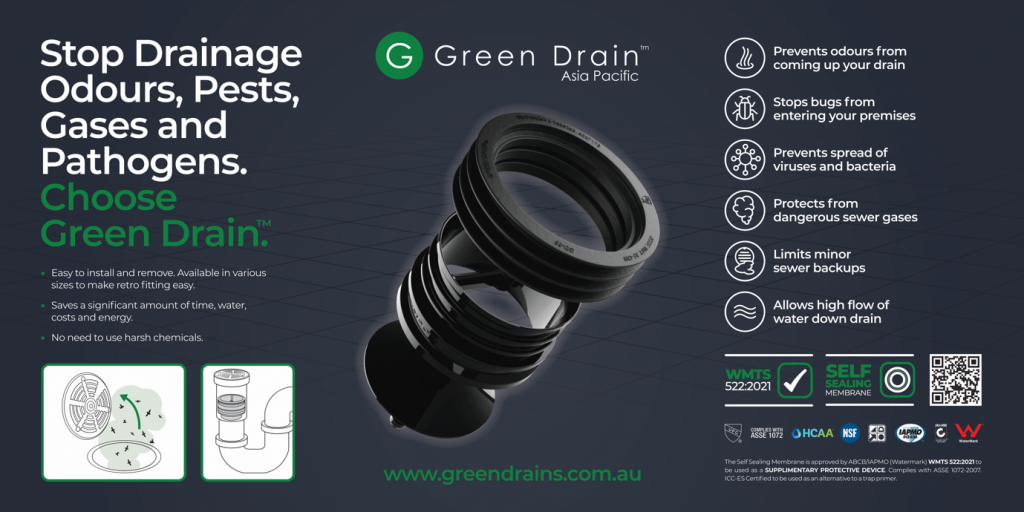
Reward Hospitality are a distributor of Green Drains waterless drain seals

